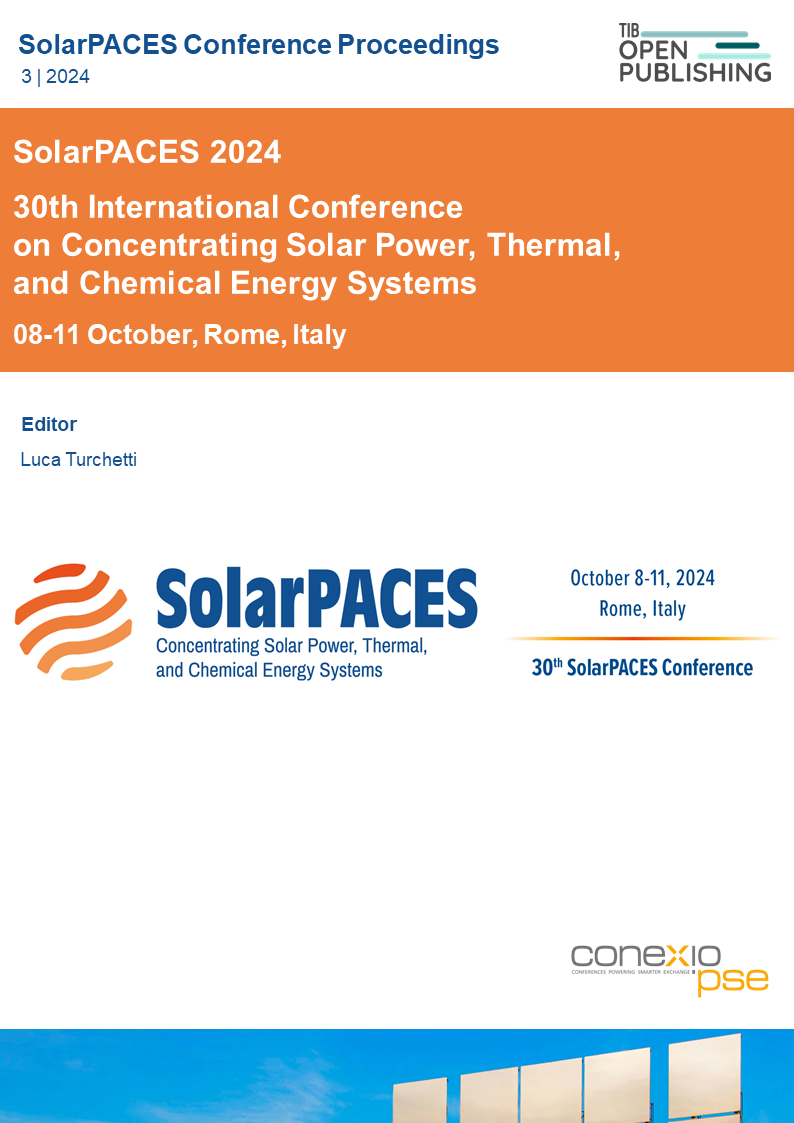Factor Estimation for Accounting Dynamic Start-Up Effects in Solar Heat Plants Using Quasi-Static Modeling
DOI:
https://doi.org/10.52825/solarpaces.v3i.2317Keywords:
Solar Heat for Process, Modelling, Transient AnalysisAbstract
Solar heat plants represent a promising solution to decarbonize the industry. However, the industry is reluctant to adopt this technology, largely due to concerns regarding the variability of solar resources. Early-stage projects rely heavily on annual simulation models to inform decision-making processes, underscoring the critical need for accurate predictions of solar plant energy yield. To address this, a methodology has been developed to enhance the precision of heat production estimates in annual steady-state modelling by integrating dynamic effects through the introduction of a heat-up factor. This heat-up factor will be dependent on the initial temperature, the DNI conditions, the heat capacitance of the installation, and the chosen control strategy. The findings demonstrate a significant enhancement in the accuracy of steady-state model simulations with the inclusion of the heat-up factor, effectively capturing the dynamic influence on energy consumption during start-up.
Downloads
References
[1] McKinsey & Company, “Net-Zero Europe,” pp. 1–204, 2020.
[2] R. Pitz-Paal et al., “Decarbonizing the German industrial thermal energy use with solar, hydrogen, and other options–Recommendations for the world,” Sol. Compass, vol. 3–4, p. 100029, Sep. 2022, doi: 10.1016/J.SOLCOM.2022.100029.
[3] T. Hirsch, et al., “Start-up modeling for annual CSP yield calculations,” J. Sol. Energy Eng. Trans. ASME, vol. 134, no. 3, 2012, doi: 10.1115/1.4006268.
[4] Noureldin, K., et al. (2017). Virtual Solar Field - Validation of a detailed transient simulation tool for line focus STE fields with single phase heat transfer fluid. Solar Energy, 146, 131–140. https://doi.org/10.1016/j.solener.2017.02.028
[5] M. Loevenich, et al. Yield Assessment Calculation and Optimization Program (YACOP) – DLR internal Documentation; 2024
[6] Lüpfert, E., et al. (2003). EUROTROUGH collector qualification complete-performance test results from PSA.
[7] Nouri, B., et al. (2020). Optimization of parabolic trough power plant operations in variable irradiance conditions using all sky imagers. Solar Energy, 198, 434–453. https://doi.org/10.1016/j.solener.2020.01.045
[8] Barnetche, M., et al. (2023). Analysis of the thermal inertia of pipelines in SHIP. https://doi.org/10.1016/j.rineng.2023.100908
[9] Nouri, B., et al. (2019). Real-time uncertainty specification of all sky imager derived irradiance nowcasts. Remote Sensing, 11(9). https://doi.org/10.3390/rs11091059
[10] Hirsch, T., et al. (2017). SolarPACES guideline for bankable STE yield assessment. IEA-SolarPACES, 190.
Published
How to Cite
Conference Proceedings Volume
Section
License
Copyright (c) 2025 Magdalena Barnetche, Tim Kotzab, Tobias Hirsch, Robert Pitz-Paal

This work is licensed under a Creative Commons Attribution 4.0 International License.
Accepted 2025-04-28
Published 2025-10-22
Funding data
-
Horizon 2020 Framework Programme
Grant numbers 884411 -
Bundesministerium für Umwelt, Naturschutz, nukleare Sicherheit und Verbraucherschutz
Grant numbers 67KI21007A
